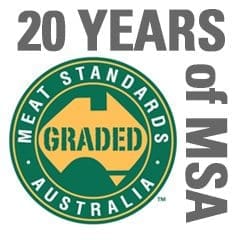THE beef industry’s new Eating Quality Graded (EQG) cipher is allowing producers to fine-tune their operations in line with consumer demands, and represents a core advantage for the Australian red meat industry, Central Queensland beef producer, Ian McCamley says.

Ian McCamley
Introduced in August last year (click here to view earlier Beef Central story), the EQG cipher relates exclusively to the eating quality of a meat sample, disregarding any reference to dentition.
For Mr McCamley, its adoption reflects a concerted effort to shift the industry away from reliance on dentition as an indication of eating quality.
“Historically, the first thing slaughter cattle were graded on was dentition,” Mr McCamley said.
“There was this industry-wide belief that the less teeth the animal had, the better the eating quality would be,” he said.
“When MSA was being developed, the science quickly showed that the number of permanent incisors had no real relevance to eating quality, and as a result this indicator wasn’t included in the MSA program.”
It was Mr McCamley’s first-hand experience having cattle MSA graded since 2007, that initially raised a query around the relevance of dentition to eating quality.
He and his wife Kate run 7000 head of cattle across their PCAS and MSA accredited operation north of Rolleston, Queensland, a third of which is also EU accredited.
Purchasing weaner steers, they grow them to liveweights around 600kg before selling them into the premium grassfed market.
“Back then, getting an animal into boning group one was the holy grail as a producer,” Mr McCamley said.
“But the processor we were selling to at the time was providing us with feedback on every beast – not just those with milk and two teeth. What this revealed was that the very first steer we ever got into Boning Group One had six teeth. Of course, this meant that despite passing the MSA and grassfed tests with flying colours, we were savagely discounted based on dentition,” he said.
“This got me started on a crusade to try and move the industry away from applying premiums and discounts based on an indicator that had no real relevance to eating quality. I didn’t think dentition was relevant, the scientists didn’t think it was relevant, and it was costing producers and the industry a lot of money.”
“Meat & Livestock Australia has now done some great work quantifying what the reliance on dentition is costing the industry, but I suspect the cost is even higher than they concluded. A lot of producers simply won’t bother sending their cattle in to be graded if they fear they might have too many teeth, and some processors won’t MSA grade cattle with more than two or four teeth.”
There was unnecessary animal and human stress caused by mouthing large cattle for no good reason, and producers often sent cattle in before they reached their optimum finish and full eating quality potential, just in case they cut too many teeth, Mr McCamley said.
“Everyone loses, including the consumer.”
Potential outcome of the Australian Beef Language Review
Mr McCamley’s role as the producer representative on the Beef Language Steering Committee in 2014 and 2015 was instrumental in the development and introduction of the EQG cipher.
“One of the key recommendations to come out of the Language Review was the introduction of a cipher based on eating quality, being MSA, with no reference to dentition. It was a major turning point,” he said.
With the industry having relied on dentition as an indicator of eating quality for so long, Mr McCamley was surprised at the pace of uptake of the EQG cipher.
“We probably underestimated the adaptability of some of the processors and brand owners, and we expected there to be more resistance than there has been,” he said.
 Despite this, he acknowledges that the benefits of the EQG cipher are still yet to fully reach producers.
Despite this, he acknowledges that the benefits of the EQG cipher are still yet to fully reach producers.
“Right now, we’re still selling our cattle on the old ciphers and being discounted based on dentition – despite processors selling a growing proportion of the beef based on the EQG cipher,” he said.
“As producers, we’re not quite there yet, but I feel the change is coming. I’m optimistic that soon we’ll start to see price grids coming back to the producer that include the EQG cipher and don’t reference dentition. I’ve been waiting more than a decade, but I’m hopeful I’ll be alive to see it.”
Reflecting on the impact of MSA to his business, Mr McCamley said it had been ‘transformational.’
“On reflection, when I think back to what we were doing pre-MSA, we’ve come leaps and bounds. In addition to the market premium we’re able to obtain, we like the whole concept of MSA,” he said.
“At the end of the day, we’re not producing just any commodity, like gravel, or coal or rubber. We’re producing food for people to eat. The more we can learn at our end to make that a better experience, the better.”
For the broader industry, Mr McCamley believes that by starting at the consumer end and working backwards, the MSA program had enabled the development of a more sustainable supply chain. It’s a strength that he feels is important to protect.
“It’s important now that we don’t take our eye off the ball. The science and data is constantly evolving, and we can’t rest on our laurels,” he said.
“If we can keep improving MSA and the understanding of various factors that impact on quality, then we’ll be better placed to sharpen our competitive edge.”
Source: MLA
